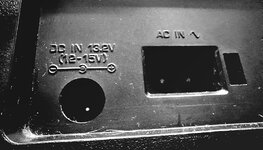It's DC circuit design learnt doing a trade. If you look at the voltage rating of the components, they are twice the nominal voltage. It's only a problem when you go to D class amp chips which are sensitive to overvoltage.
Totally inapplicable with respect to boombox (and most DC electronic circuits). It is simply inaccurate to say that voltage ratings ARE twice the nominal voltage. With circuit designs, engineers simply don't install 9 or 10 volt capacitors into a 9 volt boombox, because it is common sense to build-in a safety margin for reliability & MTBF reasons. That margin is not intended to be used for you to go over the rating, merely there for safety. On a 12 volt boombox, you'll probably find capacitors with 16 volts to be common. Firstly, that is not TWICE the rating, and the only reason it's not 12V caps is because there are common voltage steps, and 16 volts is a common step beyond the 12v rating. Is it possible for a 25v cap to be installed in a 12v circuit? Yes, but it is not at all common. As you go up in voltage, the caps cost more. Every manufacturer takes that into consideration and would never "waste" money installing something that is beyond the foreseeable circuitry needs. Are resistor and other components often rated much higher than the voltages found in circuits? Yes, but that does not mean that you can presume that voltage will not have a detrimental effect, nor can you presume that every component in a circuit will have a double voltage margin. That's because voltages that deviate from the design norms are going to cause other affects changes. For example, resistors are rated in watts but also have voltage ratings. If you merely go by the voltage rating which has a much higher margin, that does not mean you are safe. Because higher voltage will change the circuit dynamics causing increased current consumption, which is easy to exceed the rated current as resistors grow immensely in size for greater current capacity. Then there are ICs which have very exacting power demands, and easy to blow. Transistors are often biased at the base by means of voltage divider circuits. If you double the voltage, you will double the bias. Get yourself a good tutorial book on transistor biasing to learn that effect that will have on a circuit. Voltage regulators back in the day will exceed their ratings too if they have to sink more current than designed, because the amount of current sunk increases significantly the higher the source vs regulated voltage disparity grows. For example, a regulator that drops 12v to 6 volts will consume a certain amount of current based on the 6v drop. But if you increase the source voltage to 24v, that is now going to be an 18v drop and your regulator will be toast.
As for your comment that you can go higher but not lower, again that's a non-sensical statement that is plain dangerous. The additional note about capacitors trying to overcompensate for lower voltages and will overheat and fail.... well, let's see how many here are going to agree with you on that note.
Can your original opinion be true? In some cases, such as with large motors and perhaps some inductive loads. Like with automotive engine starters -- those are more watts dependent and will consume lower current as speed increases. But in no ways can what you learn about that niche apply in every electrical situation. In my opinion, you may know just enough to be dangerous and get yourself in trouble. The issue is that you often make blanket statements, which simply isn't true in every (and I'd argue most) situations. There are enough uneducated hobbyists here that may take that to heart & ruin their circuit courtesy of such statments.


